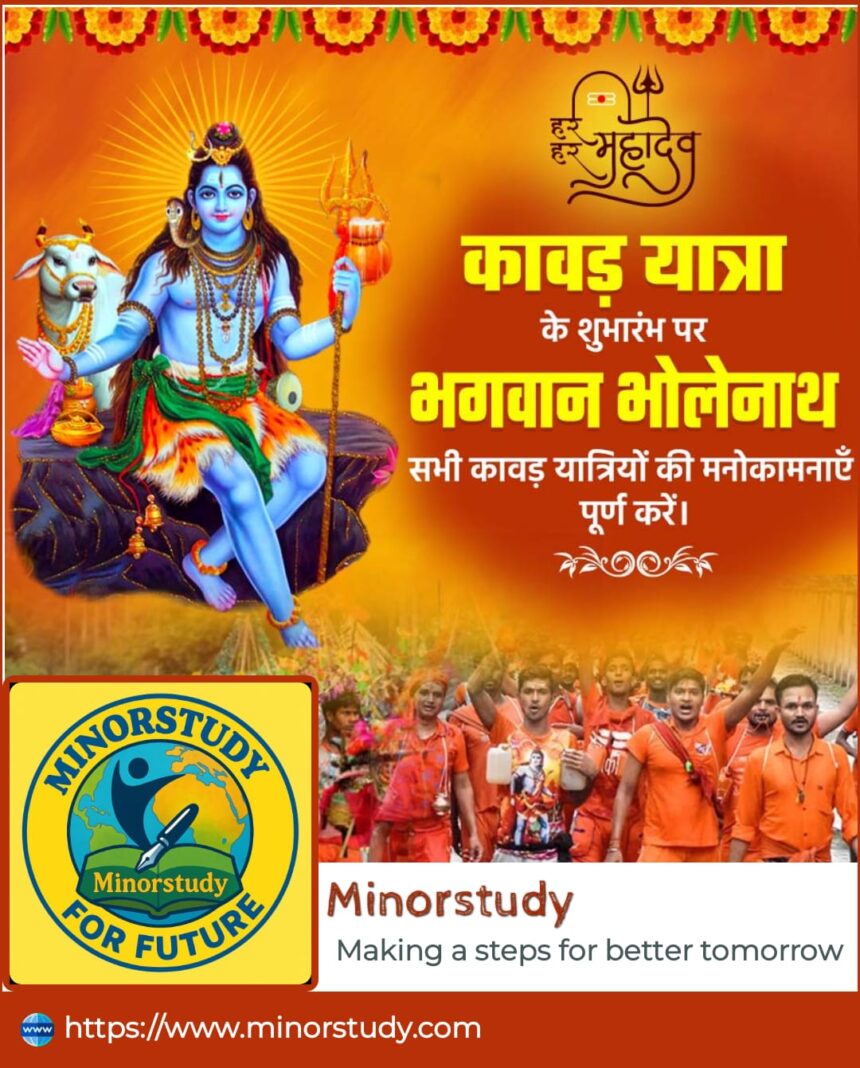🚩 Kavad Yatra: A Sacred Pilgrimage of Devotion, Discipline, and Determination
“On the commencement of Kavad Yatra, may Lord Bholenath fulfill the wishes of all Kavad pilgrims. Har Har Mahadev!”
Kavad Yatra is not just a religious journey—it’s a powerful expression of faith, surrender, and unshakable devotion to Lord Shiva. This annual pilgrimage sees millions of saffron-clad devotees, known as Kanwariyas, walking barefoot over hundreds of kilometers to fetch the holy Ganga Jal and offer it to Shiva temples, especially at Shivlingas across India.
This article explores everything about this divine tradition—history, facts, timeline, significance, observance rituals, life impact, and its societal role, all woven in a human-friendly, insightful tone with over 1200 words.

📜 History of Kavad Yatra
The Kavad Yatra dates back to ancient times, rooted in Puranic legends. The origin story connects it to the Samudra Manthan episode, where:
Lord Shiva drank the Halahala poison that emerged during the churning of the cosmic ocean to save the world.
To ease his pain, devotees began offering sacred water from the Ganga.
Devotees—Kanwariyas—carry this water in pots on a balanced bamboo pole (Kavad) and walk to deliver it to their nearest or designated Shiva temples, most notably Baidyanath Dham, Haridwar, Gangotri, and Sultanganj.
It began as an individual act of bhakti but evolved into a mass spiritual movement over centuries.
📅 Timeline of Kavad Yatra 2025 (Tentative)
| Event | Date (2025) |
|---|---|
| Shravan Maas Begins | July 10, 2025 |
| Kavad Yatra Begins | Around July 13–15 |
| Shravan Somvars | Weekly Mondays (4–5 in total) |
| Shivratri (Shravan) | August 7, 2025 |
| Yatra Ends | Around August 11–12 |
⚠️ Dates vary slightly by region. Most Yatras peak during the last week of Shravan before Shravan Shivratri.
🕉️ 9 Inspiring Facts About Kavad Yatra
Largest annual religious foot pilgrimage in the world with over 3 crore participants annually.
The term “Kanwar” refers to the bamboo pole carried with two water pots.
Pilgrims are called Kanwariyas, often dressed in saffron with chants of “Bol Bam” or “Har Har Mahadev”.
Pilgrims collect Ganga Jal from sacred rivers like Ganga (Haridwar, Gaumukh), Sultanganj (Uttarvahini Ganga).
Many Kanwariyas observe strict fasts and celibacy during the entire Yatra.
They travel by foot, bicycle, or hand carts, avoiding motor vehicles for purity.
Tricolour saffron camps, volunteer kitchens, and medical aid stations are set up along the route.
Strict rules: The Kavad must not touch the ground—if it does, the water is considered impure.
Ends with a ritualistic abhishek (bathing) of Lord Shiva’s lingam with Ganga water.
🔱 Significance of the Kavad Yatra
🧘 Spiritual Significance:
A deep expression of penance, gratitude, and surrender to Lord Shiva.
The journey purifies the mind, body, and soul, symbolizing removal of ego and embracing divine discipline.
It represents a ritual journey toward spiritual elevation.
🌍 Societal and Symbolic Importance:
Encourages values of collective participation, non-violence, and community service.
Promotes unity in diversity, with people from various castes, regions, and backgrounds joining together for a common spiritual goal.
🙏 Observances and Rituals in Kavad Yatra
1. Kavad Preparation
The bamboo pole (Kanwar) is decorated with bells, flags, pictures of Lord Shiva.
Two earthen or copper pots are tied to either side.
Pilgrims pick the route and point of Ganga Jal collection (Haridwar, Sultanganj, etc.).
2. Discipline Rules
No consumption of alcohol, meat, tobacco, or garlic-onion.
Strict celibacy, early rising, and chanting mantras like “Om Namah Shivaya” and “Bol Bam.”
No violence, lies, or theft during the Yatra.
3. Walking Rituals
Many walk barefoot, chanting all along.
The Kavad must not touch the ground.
Devotees sleep in open camps with minimal comfort.
4. Offerings
On reaching the designated Shiva temple (like Kashi Vishwanath, Baidyanath Dham, or local temples), the Ganga water is offered on the Shivling as Abhishekam.
🌟 Wishing You a Blessed Kavad Yatra
Share these heartfelt wishes:
“May Bholenath guide every step of your Kavad Yatra and fulfill all your prayers.”
“Har Har Mahadev! May this divine journey bring strength, peace, and purpose to your life.”
“Wishing all Kanwariyas a safe and spiritually enriching Yatra. Om Namah Shivaya!”

🙌 Why Kavad Yatra Is Important in Our Life
💪 Builds Willpower and Devotion
Walking for days with little comfort teaches endurance, humility, and dedication.
🧘 Improves Mental Peace
The chanting and walking meditation align body rhythms with inner calm.
🚫 Detox from Distractions
Being away from digital devices, stress, and habits, the Yatra acts as a soul reset.
🧑🤝🧑 Teaches Brotherhood
Meeting strangers who become fellow devotees fosters unity, sharing, and compassion.
🛑 Breaks Ego
The simplest act—walking and serving Shiva—reminds us of our place in the universe.
📖 Frequently Asked Questions (FAQs)
❓ Who can participate in the Kavad Yatra?
Anyone, regardless of age, gender, or caste. Even foreigners have joined in recent years.
❓ Can I ride a bike or use a vehicle for the Yatra?
Many avoid motor vehicles for spiritual reasons, but some use vehicles to cover longer distances.
❓ What are the rules regarding the Kavad?
It must not touch the ground.
The water must be offered in one go.
Avoid breaking fasts or engaging in unspiritual activities.
❓ Are women allowed in the Yatra?
Yes, women are increasingly participating, although with added safety measures and in separate groups.
💡 Key Points and Takeaways
Kavad Yatra = Bhakti + Discipline + Sacrifice.
Connected to the divine act of Shiva drinking Halahala poison.
Water symbolizes devotion, carried from Ganga to Shivling.
A growing spiritual movement, especially among the youth.
Represents the essence of Sanatan Dharma—serve, surrender, sanctify.
🎯 Conclusion – Kavad Yatra: A Journey Beyond Footsteps
The Kavad Yatra is a deeply transformative spiritual journey. It’s not about how many kilometers are walked, but how many distractions are shed, how much ego is dropped, and how much love for Bholenath is carried in one’s heart.
In a world seeking instant results, the Kanwariya walks in patience, faith, and silence. In a time of digital noise, his “Bol Bam” chant is a call to the soul. In a society torn by division, the Yatra is a river of unity.
So, as the Kavad Yatra commences, let’s fold our hands and wish:
“Har Har Mahadev! May this divine pilgrimage uplift humanity and awaken the inner Shiva in all of us.”








